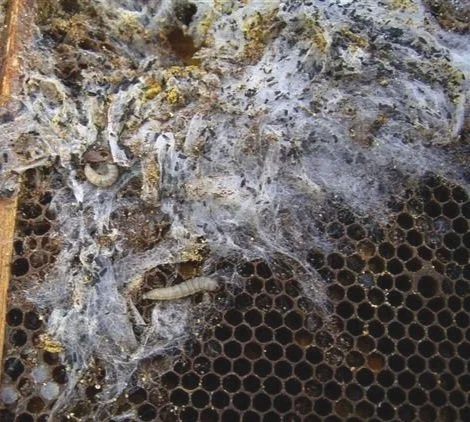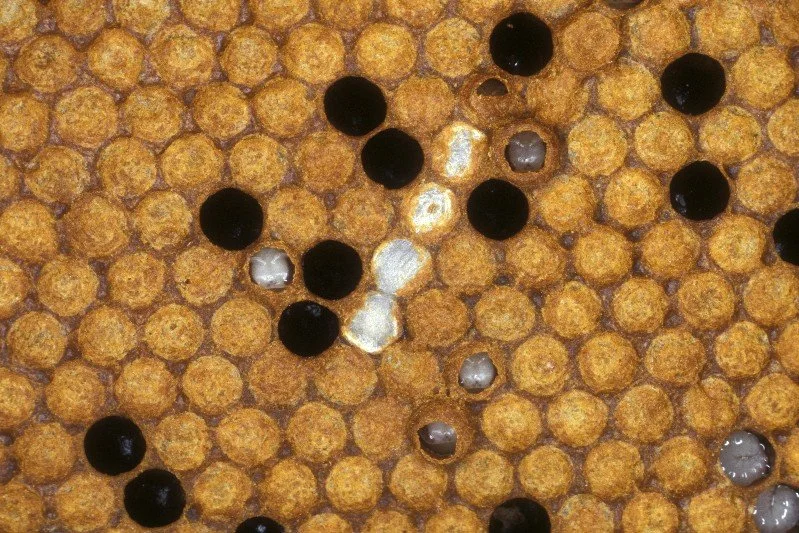
Galleria mellonella
Achroia grisella
"Between our birth and death we may touch understanding, As a moth brushes a window with its wing." - Christopher Fry
Wax Moths
Basic Assessment: Describe how comb can be stored to prevent wax moth damage
Greater wax moth © Crown copyright
Life cycle
There is Galleria mellonella, the Greater moth (18 mm long) and the Lesser one (Achroia grisella), which is one-eighth of the weight of the big one (but the small one is nearly three times the length of a clothes’ moth). The greater wax moth clears up old wax in a colony. It was first noted in Apis Cerana and has now spread worldwide. It is a severe pest in regions with warm climates. The lesser wax moth has also spread worldwide; its origin is unknown. Both, particularly the Greater Wax moth, make a mess in neglected brood comb. Greater larvae eat tiny larvae, so they are not best friends. They burrow through the comb midrib in straight lines, leaving a trail of muck and silky thread behind them (frass). Sometimes, sealed brood is uncapped. This may be due to worker bees’ hygienic behaviour. More often, it is ascribed to wax moths and called bald brood.
The moths spend up to 8 days as an egg and 15 days as a larva. The larvae grow best under warm, humid conditions and in used comb. They cannot complete their lifecycle by eating pure wax: the time until emergence is variable; in England, it is 50–55 days. The male Lesser moth is romantic because he sings to attract a mate.
Before a larva pupates, they carve a scalloped area to nestle into. In poly hives, the larvae get carried away and can wiggle through the entire thickness of the wall. They huddle together when they pupate.
Wax moth damage © Crown copyright
Bald Brood © Crown copyright
Active season
Official advice to prevent the moth from being a problem is to keep your colonies strong, which, after all, is what we are trying to do anyway. If a moth finds the hive's interior well-defended, she may try her luck by laying eggs outside the hive.
Store frames in moth-tight containers. During the summer, I keep frames in empty hives with the entrance closed and have not run into difficulties yet. I've been lucky because a moth can get through a 3 mm hole.
“Hands off,” “let alone” beekeepers who pile their hives high with supers in the spring and leave the bees to get on without inspections may become unstuck.
Methods for killing wax moth in frames before long-term storage
Acetic acid
Sulphur
Freezing
Paradichlorobenzene crystals are effective at entering the human body, and inducing cancer in rats. I think they are used in the USA, but have no place in British apiculture.
Wax moth cocoons
Larvae tunnel through comb. © Crown copyright
I’ve heard, perhaps fabricated, that some beekeepers place a spider in each box and put newspaper between boxes to prevent cannibalism.
Fumigation with 80% Acetic acid
This is unpleasant stuff. It is toxic to bees, moths, moulds, steel, mammals, concrete, and bacteria. It is also known as ethanoic acid or concentrated household vinegar. Glacial acetic acid is the pure form. Beekeeping suppliers insist that you collect it in person, but vendors on eBay will deliver it. Have a big bowl of water and eye bath on standby when handling it.
To apply acetic acid, stack the boxes and make them fume-proof—tape over cracks. However, there is a risk that tape pulls masonry paint off poly hives. So, consider slathering the edges of Beeboxes with petroleum jelly. I don’t think it makes a difference if you use plastic sheets, but metal parts need protection with jelly.
Since acetic acid is denser than air, you can administer the whole treatment in a container at the top of a stack of boxes. 120 –250ml per 4 boxes is sufficient. JD and BD Yates recommend 100ml per BS brood box. Plastic or glass containers are suitable. A cloth or kitchen towel draped over the container acts as a wick (I thought I had confirmed this, but someone else has found it unnecessary!). It is probably a temperature-dependent.
Wear full protective gear, like for oxalic acid, including a rubber apron and boots. I wear waterproof walking trousers.
Any honey in a fumigated comb is unfit for consumption.
Following Acetic acid application, you have two options
Seal the joins and leave the stacks for two weeks, then air the frames and boxes.
Alternatively, wrap them in plastic (decorator sheets work well) in the autumn and leave the pile for 6–7 months, after which the frames still smell odious and need airing. The advantage of this method is that it will fend off rodents and keep your frames safe. Be sure to create the stacks in dry weather.
Sulphur
It is ineffective against eggs, so two treatments are necessary. It is easy to use and produces noxious sulphur dioxide, which comes with the additional benefit of reducing global warming. Not only that, but it is non-toxic, so long as you don’t inhale or eat it. Thorne sell an applicator. More information:
Freezing
All wax moth life stages are killed by freezing frames overnight. This is the most popular method.
Storage
Store treated frames in moth-proof containers or hive bodies stacked on floors which have the OMF exposed.
See more information (if you have n’t already).
Read this! An international perspective on the Greater Wax moth





